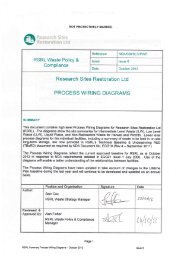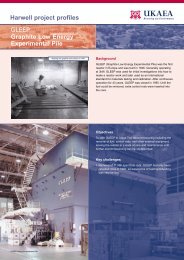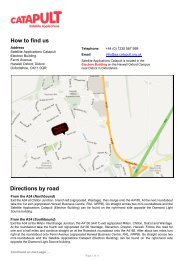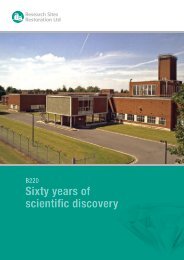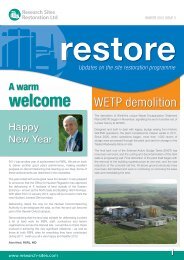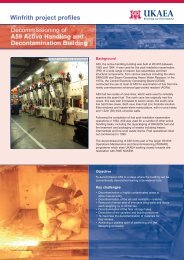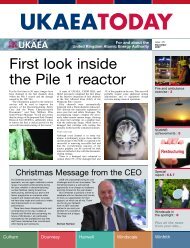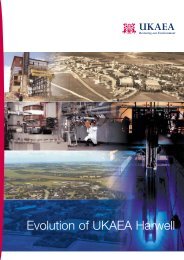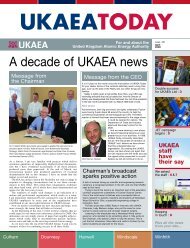RSRL Integrated Waste Strategy - Issue 5- Oct 2012.pdf
RSRL Integrated Waste Strategy - Issue 5- Oct 2012.pdf
RSRL Integrated Waste Strategy - Issue 5- Oct 2012.pdf
Create successful ePaper yourself
Turn your PDF publications into a flip-book with our unique Google optimized e-Paper software.
NOT PROTECTIVELY MARKEDliquid effluent took place. In addition, a high efficiency filtration unit was installed to filter andremove most of the finer entrained solids remaining after clarification, prior to discharge tothe sea.338. Therefore the current practice of prior treatment followed by direct discharge via the seapipeline continues to be the baseline strategy as it is for liquid foul effluent.7.2.1.4 Tritiated Groundwater339. Tritium contamination at very low concentrations is present in the groundwater on partsof the Winfrith site. During demolition operations across the Winfrith site, some operationswill involve excavation below ground level. These areas may become flooded withgroundwater, creating difficult operating and safety environments. These problemsassociated with groundwater can be overcome by dewatering. It is the management ofthese dewatering effluent arisings that are considered under this waste stream. Themanagement of the radiologically contaminated water extracted from under the nowdecommissioned Active Handling Complex is considered under the Active Liquid ProcessEffluent as the radioactivity is caesium and strontium rather than tritium.340. The site waste BPEO Study considered three options for the management of the tritiatedgroundwater: discharge to the River Win/Frome; discharge to sea using ALES; and pumpingback into the ground. In spite of the obvious environmental benefits of discharging thetritiated ground water to sea via the ALES, the risks to plant and operators from having todeal with large volumes of water above the equipment’s design capacity make this animpracticable option. Given the very low levels of tritium within the ground water, dischargeof the effluent to the River Win/Frome offers a robust management strategy, subject tomaintenance of strict controls with respect to ensuring the removal of silt prior to dischargeand controls of effluent flow rates into the river tributary. The management option ofpumping the water back into the ground offers a potential future strategy/opportunity if therewere problems with discharging the ground water to the river, however it would require moredetailed investigation before it could be practically implemented.341. The current reference strategy for the tritiated groundwater is therefore to discharge it tothe River Win/Frome. However as stated above, this will be subject to maintenance of strictcontrols to ensure discharges are kept below the levels specified in the Permit issued by theEnvironment Agency .7.2.1.5 LLW Organic Liquids342. Active waste oils and organic solvents arise in a number of facilities as a result of normaloperations and during maintenance. There are also accumulated hydraulic and lubricantwaste oils and organics solvents. The oils and organic solvents are currently storedawaiting disposal; some of these have already been consigned to an off-site incinerationservice.343. A disposal route was established in 2003 for the off-site incineration of organic liquid andcertain solid LLW. <strong>RSRL</strong> is utilising this route for disposal of contaminated oils and driedactive sewage sludge. In the past Winfrith has consigned Zinc Bromide LLW as well as alarge volume of historic active sewage drums for incineration. The use of the currentlyutilised incinerator is a key waste route for Winfrith’s organic LLW disposal strategy andWinfrith will therefore keep up-to-date with its availability.344. Several alternative management options for LLW organic liquids were considered duringthe site waste BPEO Study including high temperature combustion, chemical oxidation,disposal as a solid, storage and decay, evaporation and on-site incineration. It was agreed<strong>RSRL</strong> IWS (<strong>Issue</strong> 5 – <strong>Oct</strong>ober 2012)92




